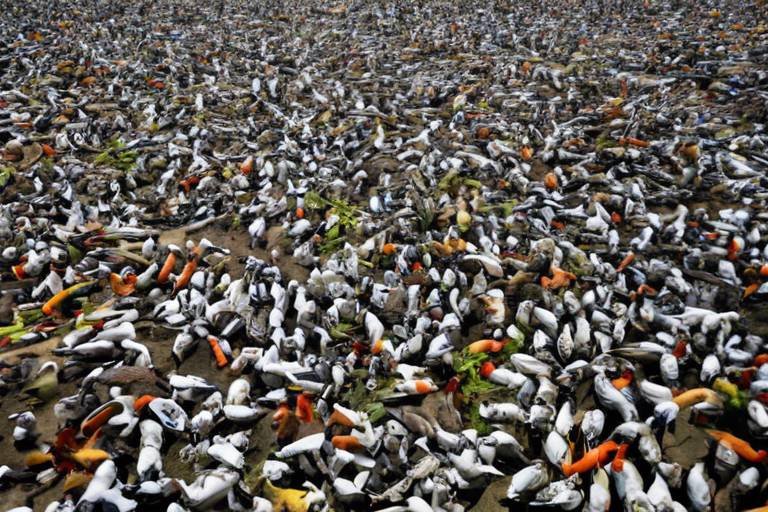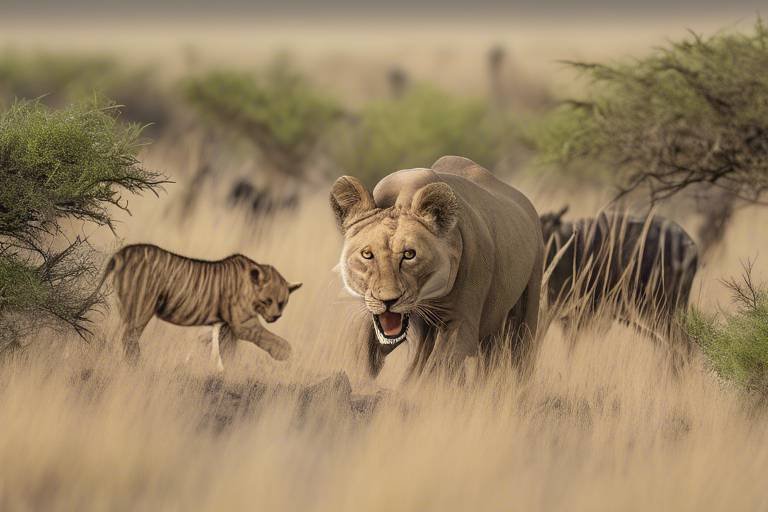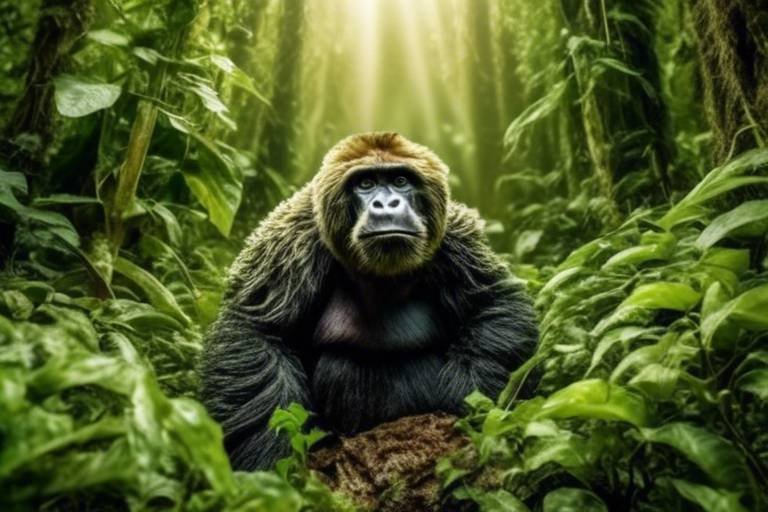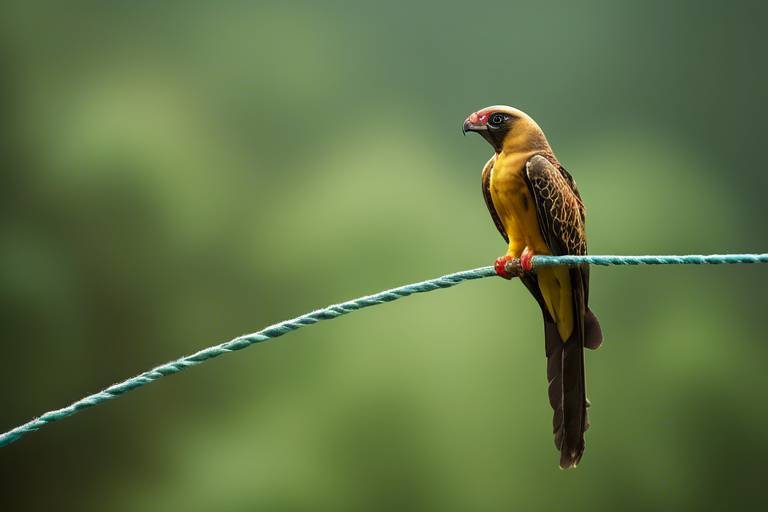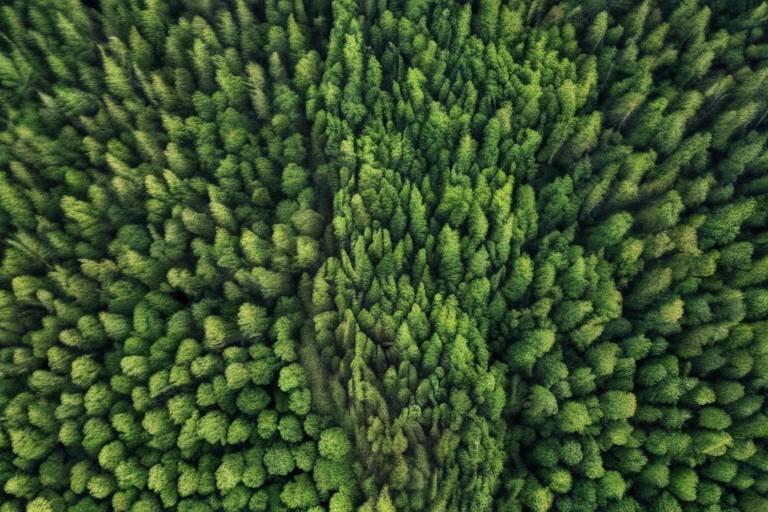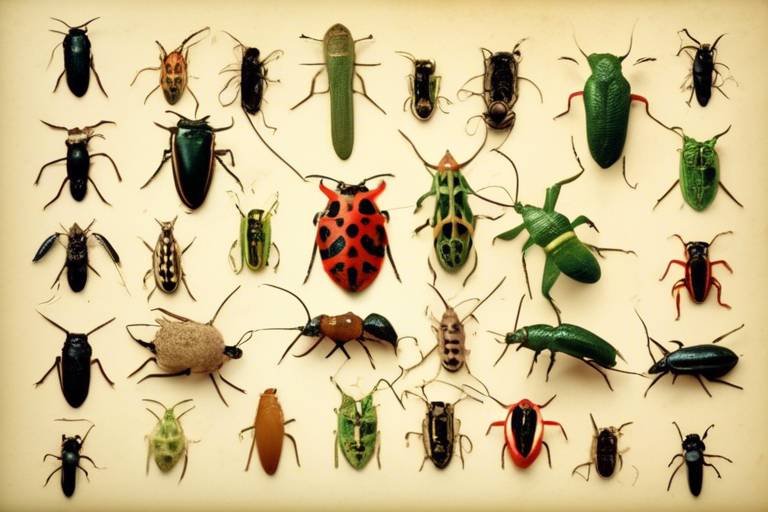Plastic Pollution and Its Deadly Impact on Biodiversity
Plastic pollution is a profound and pervasive issue that is wreaking havoc on our planet's biodiversity. From the deepest ocean trenches to the highest mountain peaks, plastic has infiltrated every corner of the Earth, creating a **silent crisis** that threatens not only wildlife but also human health. Imagine walking through a serene forest or lounging by a pristine beach, only to be confronted by the stark reality of plastic debris scattered all around. It's a shocking juxtaposition that highlights the **urgency** of addressing this environmental catastrophe.
As we dive deeper into this topic, it's essential to understand the sheer **scope** of plastic pollution. Did you know that an estimated **300 million tons** of plastic are produced globally each year? That's equivalent to the weight of the entire human population! Unfortunately, a significant portion of this plastic ends up in our ecosystems, where it can persist for **hundreds of years**. The statistics are staggering: according to recent studies, approximately **8 million tons** of plastic waste enter our oceans annually. This is like dumping a garbage truck full of plastic into the ocean every minute! Such figures are not just numbers; they represent a **grave threat** to biodiversity and the delicate balance of life on Earth.
Plastics don’t just float on the surface; they break down into smaller particles, known as microplastics, which can infiltrate the food chain. This creates a **domino effect** that ultimately impacts all forms of life, including humans. For instance, when fish ingest microplastics, these tiny particles accumulate in their bodies and can be passed on to predators, including humans, who consume seafood. Think about it: when you enjoy a fish dinner, you might be unknowingly consuming plastic. This is not just a problem for marine life; it's a **human health crisis** waiting to unfold.
The implications of plastic pollution extend beyond the oceans. Terrestrial ecosystems are also feeling the impact. Plastics disrupt soil health, affecting plant growth and the animals that depend on those plants for food. Imagine a world where our forests are choked with plastic waste, where wildlife struggles to find food, and where the very air we breathe is tainted by the degradation of these materials. It's a scenario that is becoming increasingly likely if we don't take action.
In conclusion, the deadly impact of plastic pollution on biodiversity is an urgent call to action for all of us. We need to recognize that this is not just an environmental issue; it’s a **human issue**. By understanding the scope and consequences of plastic pollution, we can begin to take steps toward solutions that protect our planet's precious ecosystems. The time to act is now, before it’s too late!
- What is plastic pollution? Plastic pollution refers to the accumulation of plastic products in the environment that adversely affects wildlife, wildlife habitat, and humans.
- How does plastic pollution affect marine life? Marine life is affected through ingestion, entanglement, and habitat destruction, leading to significant declines in species populations.
- What are microplastics? Microplastics are tiny plastic particles less than 5mm in size that result from the breakdown of larger plastic items and can enter the food chain.
- How can we reduce plastic pollution? We can reduce plastic pollution by using reusable products, recycling, supporting legislation to reduce plastic use, and participating in clean-up efforts.

The Scope of Plastic Pollution
Understanding the widespread nature of plastic pollution is crucial for grasping the full extent of its impact on our planet. Plastics have infiltrated every corner of the Earth, from the deepest ocean trenches to the most remote forests. It's staggering to think that over 300 million tons of plastic are produced each year, and a significant portion of that ends up in our ecosystems. In fact, studies estimate that approximately 8 million tons of plastic waste enter the oceans annually. This overwhelming influx of plastic not only disrupts natural habitats but also poses a serious threat to biodiversity.
To truly appreciate the scope of this issue, we must recognize how plastics are not just a coastal problem; they are a global crisis. Plastics are found in the most pristine environments, including the Arctic ice and the depths of the Mariana Trench. The ubiquity of plastic means that no ecosystem is immune to its effects. From tiny microplastics that are less than 5mm in size to massive floating debris, these materials are altering the very fabric of life on Earth.
Consider the following alarming statistics that highlight the enormity of plastic pollution:
- Over 1 million marine creatures are killed each year due to plastic pollution.
- By 2050, it is estimated that there could be more plastic than fish in the oceans by weight.
- Approximately 90% of seabirds have ingested plastic at some point in their lives.
Plastic pollution is not just a visual blight; it is a silent killer that affects the food chain, disrupts ecosystems, and ultimately threatens human health. The journey of plastic begins with its production, often derived from fossil fuels, and ends with its pervasive presence in the environment. The durability of plastic, which makes it an attractive material for many applications, also contributes to its environmental persistence. Unlike organic materials that decompose, plastics can take hundreds to thousands of years to break down, leading to a buildup that is both alarming and unsustainable.
In summary, the scope of plastic pollution is vast and alarming. It permeates our oceans, rivers, and landscapes, affecting wildlife, ecosystems, and ultimately, human health. As we continue to produce and consume plastic at an alarming rate, it becomes increasingly vital to address this issue head-on. The question remains: what can we do to combat this growing threat and protect our planet's biodiversity?

Effects on Marine Life
Marine ecosystems are like the lungs of our planet, providing essential resources and supporting a vast array of life. However, they are facing a grave threat from plastic pollution. Imagine walking along a beautiful beach, only to find it littered with plastic waste—bottles, bags, and other debris. This is not just an eyesore; it’s a silent killer for marine life. Plastics in the ocean can cause dire consequences for various species, affecting everything from the tiniest plankton to the largest whales.
One of the most alarming effects of plastic pollution is the ingestion of plastic by marine animals. Many creatures, such as sea turtles, fish, and seabirds, mistake plastic for food. This can lead to serious health issues, including internal injuries, starvation, and even death. According to recent studies, it is estimated that over 1 million marine animals die each year due to plastic ingestion. Imagine a sea turtle eating a plastic bag, thinking it’s a jellyfish. The consequences are devastating.
Moreover, entanglement in plastic debris is another significant threat. Animals can become trapped in discarded fishing nets, six-pack rings, and other plastic materials, leading to injury or drowning. This is particularly tragic for species such as seals and seabirds, which can suffer painful injuries or die as a result of these encounters. It’s like a cruel game of tag, where the players are unaware of the deadly traps set for them.
Additionally, plastic pollution disrupts the delicate balance of marine food chains. When smaller fish consume microplastics, they are inadvertently passing these harmful particles up the food chain. Larger predators, including sharks and dolphins, then consume these contaminated fish, leading to a buildup of toxins in their bodies. This bioaccumulation can have catastrophic effects on entire populations, threatening their survival.
Microplastics, tiny plastic particles less than 5mm in size, have become a ubiquitous presence in our oceans. They originate from various sources, including the breakdown of larger plastic items and the shedding of synthetic fibers from clothing. These particles are so small that they can easily be ingested by marine organisms, from plankton to fish. Studies have shown that microplastics can accumulate in the bodies of these organisms, leading to reduced growth, reproductive issues, and even death.
But the impact doesn’t stop there. Microplastics have a way of entering our food chain, ultimately making their way to our plates. This raises serious concerns about human health, as we unknowingly consume seafood contaminated with these particles. Picture biting into a delicious fish fillet, only to realize it might contain tiny plastic remnants. It’s a shocking thought, isn’t it?
Plastic pollution is not just a threat to individual animals; it poses a significant risk to entire species. For instance, the Hawksbill turtle, known for its beautiful shell, is critically endangered, and plastic pollution plays a role in its decline. These turtles often ingest plastic, mistaking it for food, which can lead to fatal consequences. Similarly, seabirds like the albatross are known to consume plastic debris, which can harm their chicks when they are fed plastic instead of nutritious food.
Coral reefs, often referred to as the "rainforests of the sea," are also suffering due to plastic pollution. The presence of plastic debris can lead to coral bleaching events, where corals lose their vibrant colors and become more susceptible to disease. This not only affects the corals themselves but also the myriad of species that depend on these ecosystems for survival. Imagine a vibrant underwater city, slowly turning gray and lifeless due to the encroachment of plastic waste.
In summary, the effects of plastic pollution on marine life are profound and far-reaching. From ingestion and entanglement to the disruption of food chains and species endangerment, the stakes are high. It’s a wake-up call for all of us to take action and protect our oceans and the incredible creatures that inhabit them.
- What are the main sources of plastic pollution in the ocean? The main sources include land-based waste, fishing gear, and microplastics from products like cosmetics and clothing.
- How can I help reduce plastic pollution? You can help by reducing single-use plastics, participating in clean-up efforts, and advocating for policies that limit plastic production.
- What are microplastics? Microplastics are tiny plastic particles that result from the breakdown of larger plastic items and can be harmful to marine life.

Microplastics and Their Impact
Microplastics, those tiny plastic particles less than 5 millimeters in size, have become a pervasive threat in our oceans and other ecosystems. They originate from various sources, including the breakdown of larger plastic debris, the shedding of synthetic fibers from clothing, and the use of microbeads in personal care products. You might be wondering, how do these minuscule particles cause such significant harm? Well, microplastics are not just floating nuisances; they are insidious invaders that infiltrate the food chain, affecting everything from plankton to the fish we consume.
Once microplastics enter the marine environment, they can be ingested by a wide range of organisms. For instance, small fish mistake these particles for food, leading to a chain reaction that can affect larger predators, including humans. Imagine biting into a delicious piece of sushi, only to find out that it contains microplastics! This scenario is becoming increasingly common, raising concerns about the safety of our seafood. Research suggests that the ingestion of microplastics can lead to physical harm, such as blockages in the digestive system, and can also introduce harmful chemicals into the bodies of marine organisms.
But the impact of microplastics doesn't stop at the ocean's surface. These particles can also absorb toxic pollutants from the surrounding water, such as heavy metals and pesticides. When marine animals consume microplastics, they are not just ingesting plastic; they are also taking in a cocktail of hazardous chemicals. This bioaccumulation poses a serious threat not only to marine life but also to human health, as these toxins can eventually make their way up the food chain.
To illustrate the severity of the situation, consider the following statistics:
| Statistic | Value |
|---|---|
| Estimated microplastics in the ocean | Over 5 trillion pieces |
| Microplastics found in seafood | Up to 1,000 particles per fish |
| Percentage of marine species affected | Over 800 species |
Given these alarming facts, it is crucial to understand the broader implications of microplastics on biodiversity. As species struggle to adapt to the presence of these pollutants, we risk losing not only individual species but entire ecosystems. The delicate balance of marine life is disrupted, leading to a decrease in biodiversity and the health of our oceans. So, what can we do about this growing crisis?
Addressing the microplastics problem requires a multi-faceted approach. Solutions range from improving waste management practices and reducing plastic production to advocating for policies that ban microbeads and promote biodegradable alternatives. Moreover, public awareness plays a vital role in combating plastic pollution. By educating ourselves and others about the impact of microplastics, we can collectively push for change and protect our planet's biodiversity.
- What are microplastics? Microplastics are tiny plastic particles less than 5mm in size, originating from the breakdown of larger plastics or from products like cosmetics.
- How do microplastics affect marine life? Marine organisms can ingest microplastics, leading to physical harm and the introduction of toxic chemicals into their bodies.
- Can microplastics impact human health? Yes, consuming seafood contaminated with microplastics can pose health risks due to the potential for toxic substances to enter the human body.
- What can be done to reduce microplastic pollution? Solutions include improving waste management, reducing plastic production, and raising public awareness about the issue.

Species Endangerment
Plastic pollution is not just an eyesore; it is a deadly threat to countless species around the globe. As plastics infiltrate marine and terrestrial ecosystems, they create a perilous environment for wildlife. Imagine a majestic sea turtle, mistaking a plastic bag for a jellyfish, or a bird entangled in a six-pack ring. These scenarios are not just hypothetical; they are happening every day. The statistics are staggering: according to recent studies, over 1 million marine creatures are killed each year due to plastic debris, and this figure is only expected to rise.
Among the most affected are species already teetering on the brink of extinction. For instance, the Hawksbill turtle, known for its beautiful shell, is critically endangered and faces significant threats from plastic pollution. These turtles often ingest plastics, which can lead to severe internal injuries or even death. Similarly, the Vaquita, the world's rarest marine mammal, is not only suffering from habitat loss but also from the entanglement in fishing nets made of plastic. The situation is dire, and without immediate action, we risk losing these incredible species forever.
Furthermore, the impact of plastic pollution extends beyond individual species. It disrupts entire ecosystems, leading to a cascade of consequences that can threaten biodiversity as a whole. For example, when larger predators, like sea lions, consume fish that have ingested microplastics, it can result in a decline in their populations as well. This creates an imbalance in the food chain, affecting everything from plankton to large marine mammals.
In light of these alarming realities, it is imperative that we recognize the urgency of the situation. Conservation efforts must be prioritized, and it is crucial to develop effective strategies to mitigate plastic pollution. This includes not only reducing plastic production but also implementing robust recycling programs and encouraging the use of biodegradable alternatives. By taking collective action, we can protect endangered species and preserve the delicate balance of our ecosystems.
- What are the main causes of species endangerment due to plastic pollution?
Species endangerment is caused by ingestion of plastics, entanglement, and habitat destruction, leading to diminished populations and disrupted ecosystems. - How can individuals help combat plastic pollution?
Individuals can reduce plastic use, participate in clean-up efforts, and advocate for policies promoting sustainable practices and alternatives to plastic. - Are there any successful initiatives aimed at protecting endangered species from plastic pollution?
Yes, various organizations are focusing on cleaning oceans, educating communities, and supporting legislation aimed at reducing plastic waste.

Coral Reefs and Plastic
Coral reefs, often referred to as the "rainforests of the sea," are among the most diverse and vibrant ecosystems on our planet. However, they are facing a silent killer: plastic pollution. You might be wondering, how do plastic waste and coral reefs even connect? Well, the reality is, plastics can smother corals, block sunlight, and even introduce harmful chemicals into these delicate environments.
When plastic debris enters the ocean, it can be mistaken for food by marine creatures. For instance, turtles often confuse plastic bags with jellyfish, leading to ingestion that can cause severe internal injuries or even death. But the threat doesn’t stop there. As plastics break down into microplastics, they become even more insidious. These tiny particles can settle on coral reefs, disrupting the symbiotic relationship between corals and the algae (zooxanthellae) that live within them. This relationship is crucial because it provides corals with the energy they need to thrive.
Moreover, the presence of plastics can exacerbate coral bleaching events. When corals are stressed—whether from rising ocean temperatures or pollution—they expel the algae, leading to a loss of color and essential nutrients. Studies have shown that reefs surrounded by high levels of plastic debris are more susceptible to bleaching. This creates a vicious cycle: as reefs become weaker, they are less able to recover from environmental stressors, further endangering their survival.
Here’s a quick breakdown of the impacts of plastic pollution on coral reefs:
- Smothering: Large plastic items can physically cover corals, preventing them from receiving sunlight.
- Toxicity: Plastics can leach harmful chemicals into the water, which can be detrimental to coral health.
- Increased Disease: The stress caused by plastic pollution can make corals more susceptible to diseases.
In addition to these direct impacts, the presence of plastic can also hinder conservation efforts. Marine protected areas, designed to safeguard coral reefs, may struggle to maintain their integrity when surrounded by plastic waste. This not only affects the corals but also the myriad of species that depend on these ecosystems for survival. If we continue to ignore the link between plastic pollution and coral health, we risk losing one of the most biodiverse habitats on Earth.
In conclusion, the relationship between coral reefs and plastic pollution is a stark reminder of how interconnected our ecosystems are. Protecting coral reefs from plastic waste is not just about preserving beauty; it is vital for maintaining biodiversity and the health of our oceans. As stewards of the planet, we must take action to reduce plastic consumption and promote cleaner oceans for future generations.

Impact on Terrestrial Ecosystems
The impact of plastic pollution on terrestrial ecosystems is a pressing issue that often flies under the radar. While we frequently hear about the devastating effects of plastics in our oceans, the land is not exempt from this crisis. Plastics can be found littering our parks, forests, and even remote areas, creating a hazardous environment for wildlife and plants alike. Imagine a beautiful forest, teeming with life, now marred by discarded plastic bags and bottles. It’s not just an eyesore; it’s a threat to the very fabric of these ecosystems.
As plastics break down into smaller pieces, they can leach harmful chemicals into the soil, affecting its quality and the health of the plants that grow in it. This degradation can lead to a decline in soil fertility, making it challenging for crops to thrive. Furthermore, these chemicals can enter the food chain, impacting not only wildlife but also humans who rely on these crops for sustenance. The consequences are far-reaching, illustrating that plastic pollution is not just an environmental issue, but a fundamental threat to food security.
Wildlife is particularly vulnerable to the encroachment of plastic in their habitats. Animals may ingest plastic debris, mistaking it for food, which can lead to malnutrition, internal injuries, or even death. For example, terrestrial birds often consume plastic fragments, which can accumulate in their digestive systems, causing blockages and other health issues. Similarly, mammals, such as deer or raccoons, can become entangled in plastic waste, leading to injuries that hinder their ability to survive.
Additionally, plastics can disrupt the delicate balance of terrestrial ecosystems. They can interfere with the natural processes of decomposition, which is crucial for nutrient cycling. When plastics accumulate in the soil, they can inhibit the growth of beneficial microorganisms that contribute to soil health. This disruption can create a cascade of negative effects, ultimately leading to a decline in biodiversity. The loss of certain plant species can affect the entire ecosystem, as these plants provide habitat and food for various animals.
In urban areas, the impact of plastic pollution is even more pronounced. Streets and neighborhoods can become hotspots for plastic waste, which not only affects aesthetics but also poses health risks. Rainwater can wash plastics into storm drains, leading to pollution in local waterways. This runoff can carry toxins into rivers and lakes, further extending the reach of plastic pollution beyond its original source. The cycle of pollution continues, highlighting the urgent need for comprehensive waste management solutions.
To tackle this issue effectively, we must adopt a multifaceted approach. Education and awareness campaigns can play a crucial role in changing consumer behavior and encouraging responsible plastic use. Moreover, implementing stricter regulations on plastic production and disposal can help mitigate this growing problem. Local communities can also engage in clean-up initiatives, fostering a sense of stewardship for their environments.
In summary, the impact of plastic pollution on terrestrial ecosystems is profound and multifaceted. From harming wildlife to degrading soil health, the consequences of plastic waste are far-reaching. As we continue to grapple with this crisis, it is essential to recognize that every piece of plastic we discard has the potential to disrupt the delicate balance of nature. Together, we can work towards solutions that protect our planet and its biodiversity.
- What are microplastics, and how do they affect terrestrial ecosystems?
Microplastics are tiny plastic particles that result from the degradation of larger plastic items. They can contaminate soil and water, harming wildlife and disrupting food chains. - How can individuals help reduce plastic pollution?
Individuals can help by reducing their use of single-use plastics, participating in local clean-up efforts, and advocating for policies that limit plastic production and waste. - What are the long-term effects of plastic pollution on human health?
Long-term exposure to plastics and the chemicals they release can lead to various health issues, including hormonal disruptions, reproductive problems, and increased cancer risks. - Are there alternatives to plastic that can be used in everyday life?
Yes, alternatives such as glass, metal, and biodegradable materials can replace many single-use plastic items, helping to reduce overall plastic waste.

Human Health Risks
Plastic pollution doesn’t just wreak havoc on our planet's ecosystems; it also poses serious risks to human health. As we continue to consume seafood and other products that may be contaminated with microplastics, the implications of this pollution become increasingly alarming. Have you ever thought about what happens when plastic breaks down into tiny particles? These microplastics find their way into our food chain, and ultimately, onto our dinner plates. This alarming reality raises questions about the safety of the food we consume and the long-term effects of exposure to these pollutants.
When we talk about microplastics, we are referring to plastic particles that are less than 5 millimeters in size, often invisible to the naked eye. They originate from larger plastic debris that has broken down over time, as well as from products like cosmetics and synthetic fibers. Recent studies have shown that microplastics have been detected in various food items, including fish, shellfish, and even table salt. This means that we are not just spectators in this crisis; we are active participants, unknowingly ingesting these harmful particles.
But the risks don’t stop at ingestion. The degradation of plastics releases a cocktail of harmful chemicals into the environment. These chemicals, such as bisphenol A (BPA) and phthalates, are known endocrine disruptors, which means they can interfere with our hormonal systems. The consequences of such exposure can range from reproductive issues to increased risks of certain cancers. It’s a grim reality that we must face: the very materials we use for convenience can have a profound impact on our health.
To illustrate the severity of this issue, consider the following table that summarizes some of the health risks associated with plastic pollution:
| Health Risk | Description |
|---|---|
| Endocrine Disruption | Chemicals from plastics can interfere with hormone function, leading to reproductive issues. |
| Carcinogenic Effects | Some plastic additives are linked to increased cancer risks. |
| Digestive Issues | Ingestion of microplastics can lead to inflammation and other gastrointestinal problems. |
| Neurological Effects | Certain chemicals found in plastics may affect brain development and function. |
Furthermore, the economic implications of plastic pollution extend beyond environmental concerns. Communities that rely on fishing and tourism are particularly vulnerable. Imagine a coastal town where the fishing industry is thriving, only to find that their catch is tainted with microplastics. The result? A decline in tourism, loss of livelihoods, and a community grappling with the fallout of plastic pollution. It's a ripple effect that touches every aspect of life.
So, what can we do to mitigate these risks? Awareness is the first step. By educating ourselves and others about the dangers of plastic pollution, we can make more informed choices. Reducing our reliance on single-use plastics, supporting policies aimed at reducing plastic waste, and advocating for cleaner oceans and ecosystems are crucial actions we can take. Remember, every small change adds up to a significant impact.
- What are microplastics? Microplastics are tiny plastic particles that result from the breakdown of larger plastic debris or from products like cosmetics and synthetic clothing.
- How do microplastics affect human health? Ingestion of microplastics can lead to various health issues, including endocrine disruption, digestive problems, and potential carcinogenic effects.
- What can I do to reduce plastic pollution? You can reduce plastic pollution by minimizing the use of single-use plastics, supporting recycling initiatives, and advocating for policies that protect the environment.

Pollutants and Toxins
When we talk about plastic pollution, it’s not just about the visible trash floating in our oceans or littering our parks. It's about the invisible danger lurking beneath the surface—pollutants and toxins that plastics release as they degrade. Over time, plastics break down into smaller and smaller pieces, a process that can take hundreds of years. During this decomposition, they leach a cocktail of harmful chemicals into the environment, which can have devastating effects on both wildlife and human health.
One of the most concerning aspects of plastic degradation is the release of toxic substances such as phthalates, bisphenol A (BPA), and heavy metals. These substances can disrupt hormonal systems, lead to reproductive issues, and even contribute to the development of cancers. Imagine a plastic bottle sitting in a landfill, quietly leaching toxins into the soil and groundwater, which eventually makes its way into our food chain. This is not just a hypothetical scenario; it’s a reality that we are facing today.
Moreover, when marine animals ingest microplastics, they not only suffer from physical harm but also absorb these chemicals into their bodies. This creates a ripple effect throughout the food chain, impacting larger predators, including humans. The potential for bioaccumulation and biomagnification means that the concentrations of these toxins can become dangerously high in top predators. For instance, fish that consume microplastics can carry these toxins into the bodies of those who eat them—us!
To illustrate the severity of this issue, consider the following table that summarizes some of the most common pollutants associated with plastic degradation and their potential health impacts:
| Pollutant | Source | Health Impact |
|---|---|---|
| Phthalates | Plasticizers in PVC | Hormonal disruption, reproductive issues |
| BPA | Polycarbonate plastics | Endocrine disruption, potential cancer risk |
| Heavy Metals | Degradation of plastic products | Neurological issues, developmental problems |
It's clear that the consequences of plastic pollution extend far beyond the immediate environmental impact. The toxins released from plastics can infiltrate our bodies, leading to a range of health issues that we are only beginning to understand. So, the next time you see a plastic bag blowing in the wind, remember that it’s not just an eyesore; it’s a potential source of harmful pollutants that could affect the health of our planet and ourselves.
In conclusion, the fight against plastic pollution is not merely about cleaning up our parks and beaches; it's about safeguarding our health and the health of future generations. We must take action to reduce plastic use, support policies that limit plastic production, and advocate for cleaner alternatives. After all, a cleaner environment means a healthier future for all living beings.
- What are microplastics? Microplastics are tiny plastic particles less than 5mm in size that result from the breakdown of larger plastic items or are manufactured as small particles.
- How do plastics affect human health? Plastics can release harmful chemicals into the environment, which can enter the food chain and affect human health, leading to various health issues.
- What can I do to reduce plastic pollution? You can reduce plastic pollution by using reusable bags, bottles, and containers, avoiding single-use plastics, and supporting recycling initiatives.

Community and Economic Impacts
Plastic pollution is not just an environmental crisis; it's a community and economic disaster waiting to happen. Local communities, especially those near coastlines, are often the first to feel the impacts of plastic waste. Imagine walking along a beautiful beach, only to find it littered with plastic debris. This not only tarnishes the natural beauty but also affects the mental and physical well-being of the residents. The presence of plastic waste can deter tourists, leading to a significant drop in local businesses that rely on tourism for survival.
Moreover, the costs associated with cleaning up plastic pollution can be staggering. Municipalities often struggle to allocate funds for waste management, leading to a backlog of clean-up efforts. According to recent studies, communities spend millions of dollars each year on plastic waste management. For instance, a 2021 report found that U.S. cities spent approximately $11 billion annually on waste management, with a substantial portion directed towards tackling plastic pollution alone. This financial burden can divert resources from essential services like education and healthcare, creating a ripple effect that impacts the entire community.
Additionally, the fishing and agricultural industries are not immune to the effects of plastic pollution. Fishermen often report that their catches are contaminated with microplastics, which not only diminishes the quality of seafood but also raises health concerns for consumers. As a result, the marketability of fish and shellfish diminishes, leading to reduced income for fishermen and affecting food security for communities dependent on these resources. The agricultural sector also suffers as plastic waste contaminates soil and water sources, affecting crop yields and farmer livelihoods.
In summary, the economic implications of plastic pollution extend far beyond environmental degradation. They touch the very fabric of community life, impacting health, tourism, and local economies. Addressing this crisis requires not just environmental action but a concerted effort to support affected communities and industries.
- What are the main economic impacts of plastic pollution? The main economic impacts include increased waste management costs, loss of tourism revenue, and declines in fishing and agricultural productivity.
- How does plastic pollution affect local communities? Local communities face environmental degradation, reduced quality of life, and economic challenges due to the presence of plastic waste.
- What can communities do to mitigate the effects of plastic pollution? Communities can implement recycling programs, promote awareness campaigns, and support local legislation aimed at reducing plastic use.
Frequently Asked Questions
- What is plastic pollution?
Plastic pollution refers to the accumulation of plastic products in the environment, which adversely affects wildlife, ecosystems, and human health. It's a growing global crisis, with millions of tons of plastic waste entering our oceans and landscapes every year.
- How does plastic pollution impact marine life?
Marine life suffers greatly from plastic pollution. Animals can ingest plastic debris, mistaking it for food, which can lead to malnutrition or death. Additionally, larger pieces of plastic can entangle marine animals, causing injury or drowning. The disruption of food chains due to plastics can also have long-lasting effects on marine ecosystems.
- What are microplastics and why are they a concern?
Microplastics are tiny plastic particles less than 5mm in size, often resulting from the breakdown of larger plastic items. They are a concern because they can easily enter the food chain, affecting marine organisms and potentially posing health risks to humans who consume contaminated seafood.
- Which species are most affected by plastic pollution?
Several species are endangered due to plastic pollution, including sea turtles, seabirds, and certain fish species. These animals often ingest or become entangled in plastic debris, leading to injury and, in some cases, extinction.
- How does plastic pollution affect coral reefs?
Plastic pollution negatively impacts coral reefs by contributing to coral bleaching and reducing overall reef health. Plastics can smother corals and introduce harmful toxins, which can disrupt the delicate balance of reef ecosystems.
- What effects does plastic pollution have on terrestrial ecosystems?
Plastic pollution affects terrestrial ecosystems by contaminating soil and harming wildlife. Animals can ingest plastic, mistaking it for food, which can lead to health problems. Additionally, plastics can disrupt plant growth and soil health, affecting entire ecosystems.
- What are the human health risks associated with plastic pollution?
Humans face health risks from plastic pollution, particularly through the consumption of contaminated seafood. Chemicals released from degrading plastics can enter the human body, potentially leading to various health issues, including hormonal disruptions and increased cancer risk.
- What pollutants are associated with plastic degradation?
When plastics degrade, they release harmful pollutants such as bisphenol A (BPA), phthalates, and other toxic chemicals. These pollutants can leach into the soil and water, affecting both ecosystems and human health.
- How does plastic pollution impact local communities and economies?
Plastic pollution can have significant economic impacts on local communities, particularly those reliant on healthy ecosystems for tourism and fishing. The costs associated with cleanup efforts can strain local budgets, while declining marine and terrestrial health can affect livelihoods.


